| Bionic Choreography
By staff reporter XING WEN
|
 |
|
The movements of the Five-Animal Routine mimic the tiger, deer, bear, monkey and crane. |
REVERENCE for and interaction with nature and other beings is the key to traditional Chinese culture and was interwoven with all aspects of life and society in ancient China, including philosophy, architecture and healthcare. As early as 2,000 years ago a gymnastic routine was created by mimicking the movements of five animals that were believed to work muscles in the best way and stimulate the flow of qi, the intangible flow of vital energy, in the human body. Its inventor is Hua Tuo, known as the Chinese Hippocrates.
A prominent doctor in the Eastern Han Dynasty (25-220), Hua Tuo was devoted to medical research and the practice of medicine. He was the first in China to perform surgery. Then to staunch the pain of patients going under the knife, he formulated the world's first anesthetic, a concoction of several kinds of herbs – some 1,600 years before Europeans began to use anesthesia in surgeries. Hua Tuo's theories on anatomy, acupuncture and moxibustion are still in practice today.
Huo Tuo traveled a lot, receiving patients and at the same time learning from folk doctors all over the nation. He gradually realized that exercise could effectively prevent disease. His theory is that physical activity would keep vital energy flowing smoothly through the meridians and collaterals of the human body so as to encourage vigor and eliminate sickness. But he cautioned exercise should never be overdone.
The Chinese people were clearly impressed by wild animal species that had their own ways to survive in harsh conditions. Believing their movements were beneficial for health, people observed and imitated them, giving rise to some primitive prescribed movements. For instance, the Taoist classic Zhuangzi wrote: to strive for longevity, breathe deeply to let out stale air and bring in fresh air, and do what a bear does when climbing a tree and follow the example of birds flying and stretching their claws. Hua Tuo's studies resulted in the selection of five animals to imitate – bear, tiger, deer, crane and monkey. He then integrated their movements with qigong, forming a more robust choreographed exercise that is designed to develop human flexibility, strength and balance.
Though appearing unsophisticated, the practice is not only a set of movements for the torso and limbs, but also involves the use of eyes and fingers, and the control of breathing and meditation. Before starting the routine, one must relax and imagine the animal to be imitated. The principle is to catch the essence of the creature's natural postures. That is to say, a practitioner is supposed to capture a bear's slowness and stillness, a tiger's prowess, a deer's elegance, the lightness of a crane or the agility of the monkey.
|
